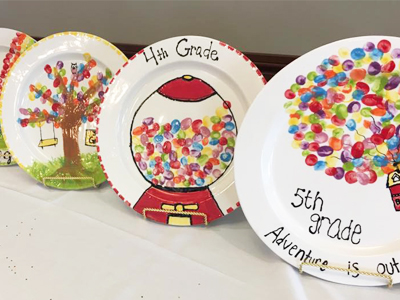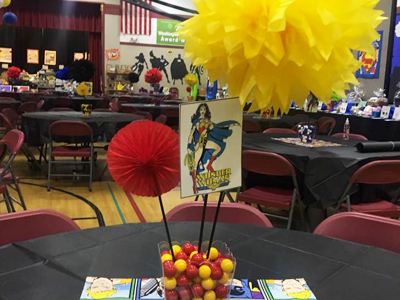Silent Auction Fundraiser Basics

There’s a reason these old-fashioned school fundraisers remain popular in the high-tech era. With good planning, silent auctions can be reliably profitable events.
From classroom baskets to vacation packages, silent auctions offer the chance for some great prizes for bidders—and substantial profits for your group.
Why Hold a Silent Auction?
Because most of the items sold are typically donated, silent auctions have the potential to make good money for school parent groups. The auctions also let supporters purchase something they want while benefiting the PTO or PTA at the same time.
Points To Consider First
Anyone who’s organized a silent auction will tell you it’s a lot of work. Start planning your auction up to six months before the event, and start promoting it a few months ahead of time.

The success of your silent auction comes down to your outreach for donations, your pre-event organization, the venue, and—above all—the quality of your items. What you have available for bidding is really what will make or break your event.
Join the PTO Today community (it's free) for access to resources, giveaways and more
Getting Your Silent Auction Items Together
Without items people want, your auction will fall flat—so you need to provide a mix of different types of desirable items. Spend some time brainstorming with your committee about what you want to include, like:
-
Items that are perceived as hard to get (sport or concert tickets, a gift certificate to a “hot” restaurant, etc.)
-
Items with high intangible value (experiences like lunch with the principal, student crafts, etc.)
-
Items that are always popular (wine, golf, weekend getaways with no strings attached, etc.)
-
Theme baskets (gardening, travel, reading, coffee, Christmas, etc.)

Download 148 Silent Auction Items and More for more ideas.
How you get your auction items will depend on what they are, but you should plan to look at a variety of sources:
Ask what your school can give. This can include students’ classroom art, a preferred parking spot, the chance for a student to be principal for a day, and more.
Business donations are a mainstay for helping groups secure good auction items. It can require some patience and persistence to work with businesses, but it pays off in the end. The article “10 Steps to Getting Business Donations for Your PTO” walks you through the process.
Auction items from parents can run the gamut from professional services like painting and accounting to special skills like making a custom T-shirt quilt or providing guitar lessons. If you know a parent has expertise that would lend itself to an auction item, ask.
Many schools ask individual classrooms to provide the items for theme baskets; it doesn’t weigh too heavily on any one family if they’re only contributing a single item toward a larger donation. Once you have the items in hand, watch our step-by-step auction basket video before putting yours together.
Silent Auction Logistics and Organization
Venue: Because an auction is a high-profile event for many schools, some choose to move theirs off-campus to a more comfortable or higher-end location like a banquet hall or community center. But your auction really can be anything you want it to be; if you think your school community would prefer a more casual setting (like the school itself), plan for that. Whatever venue you choose, be sure it’s close by, easy for guests to find, and able to support the requirements of your event.

Food: If you’re holding a standalone event, plan to serve food. It doesn’t have to be a full meal—in fact, hors d’oeuvres or small plates can be more practical for people walking around and bidding on items. Often you can find local businesses willing to donate platters; alternatively, some schools plan a dessert event where parents or businesses donate desserts and the PTO provides beverages. If you choose to go a more casual route, it’s fine to serve food that matches that approach. Whatever you choose, include costs like plates and utensils in your bottom line.
Volunteers: Silent auctions depend on adequate volunteer help to keep things going smoothly. You’ll need people to help with setup, handling money, keeping an eye on inventory, general running, checkout, and more.
Publicity: Thinking ahead about how to promote your silent auction can help maximize participation (and increase profits). Starting as early as eight weeks in advance, hang flyers and email parents to tease high-interest items and let them know what forms of payment will be accepted. Post reminders on Facebook and ask administrators to share the details during morning announcements as the event date gets closer.
Event Setup
Each item should have a description sheet alongside it. Catchy descriptions can get bidders’ attention; you also want to let attendees know exactly what they’re bidding on. Does anyone on your committee have a flair for writing? Consider appointing her the description writer, and encourage her to get creative with the writing, how the descriptions are displayed with the items, and if possible, visuals or graphics.

Each item also needs to have a silent auction bid sheet, the document used for bidding and recording.
-
The top of the sheet should repeat the key details from the description sheet: auction item number, description, value, donor, any restrictions on the item, and a visual element if space allows.
-
The middle area should include the minimum opening bid and the requested bid increment. Groups typically set opening bids as a percentage of the value of an item, such as 30 or 50 percent, and recommend bid increments of $1, $5, or $10, depending on the item’s value. Include at least 10 lines for guests to enter their name or bidder number and a bid amount.
-
You can also have a section at the bottom of the bid sheet that gets cut off to serve as a claim check when the buyer pays and needs to collect the item.
Lots of schools up the allure of their silent auction by giving it a theme like a decade, tailgating, or luau.

Silent Auction Closeout and Checkout
Procedures for closeout and checkout can vary, but all groups want to make the process as quick and as seamless as possible. With that in mind, consider these points (and give bidders a heads up on how it will work):
For larger events, some groups close out in phases or waves, which builds in some excitement and also gives organizers time to enter winning bids as remaining items are still being bid on.
Another closeout tactic is for the master of ceremonies to let people know bidding is about to close. At the appointed time, the runners will circle the winning bidder/bid amount, remove the sheet from the table, and write the winning bidder and bid amount on the second page of the bid sheet. (The second page stays on the table so guests can see who won the item.) Runners deliver the original bid sheets to the cashiers, where they’re consolidated by bidder and tallied for checkout.
For checkout, plan on three to four cashiers, depending on the size of your crowd. Provide each cashier with a cash box with change, device used for credit card transactions, office supplies, a list of guest names with bidder numbers, and a list of auction items. Encourage guests to approach any available cashier; setting up roped queue lines or alphabetic assignments isn’t as efficient.
It’s fine to leave most items in place until the winners or runners pick them up; common sense can dictate which items you might keep at checkout instead (like jewelry). Runners can help bidders identify items and pack up their winnings. Some groups insist that items be picked up that night; others will try to accommodate later pickup of unclaimed items.






















